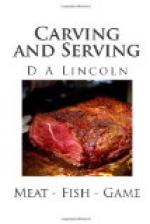Calf’s head served whole is a favorite dish in England, but seldom seen on American tables. For those who have this preference a few hints about carving may be desirable. Place it on the platter with the face toward the right. Cut from left to right, through the middle of the cheek down to the bone, in several parallel slices of medium thickness; then separate them from the bone. Cut down at the back of the throat and slice the throat sweetbread. With the point of the knife cut out the gelatinous portion near the eye, and serve to those who desire it. There is a small portion of delicate lean meat to be found after removing the jawbone. Some are fond of the palate, which lies under the head. The tongue should be sliced, and a portion of this and of the brains offered to each person.
ROAST PIG.
This is sometimes partly divided before serving. Cut off the head and divide it through the middle; then divide through the backbone. Place it on the platter back to back, with half the head on each end of the dish.
If the pig be very young, it is in better style to serve it whole. Before cooking, truss the forelegs forward and the hind legs backward. Place the pig on the platter with the head at the left. Cut off the head, separating the neck-joint with the point of the knife, then cut through the flesh on either side. Take off the shoulders by cutting in a circle from under the foreleg round nearly to the backbone and down again. Bend it forward and cut through the joint. Cut off the hams in the same way. Then split the backbone the entire length and divide between each rib. Cut slices from the thickest part of the hams and the shoulders. The ribs are the choice portion, but those who like it at all consider any part of it a delicacy.
HAM.
If the ham is not to be served whole, the simplest and most economical way is to begin near the smaller end and cut in very thin slices, on each side of the bone. Divide the slices and arrange them neatly on the dish, one lapping over another, with the fat edge outside.
Where the whole ham is to appear on the table it should be trimmed neatly, and the end of the bone covered with a paper ruffle. The thickest part should be on the further side of the platter. Make an incision through the thickest part, a little way from the smaller end. Shave off in very thin slices, cutting toward the larger end and down to the bone at every slice. The knife should be very sharp to make a clean cut, and each slice should have a portion of the fat with the crisp crust. To serve it hot a second day, fill the cavity with a bread stuffing, cover it with buttered crumbs, and brown it in the oven. If it is to be served cold, brown the crumbs first and then sprinkle them over the stuffing. If this be done the edges will not dry and the symmetry of the ham is preserved. Carve as before, toward the larger end, and if more be needed, cut also from the other side of the bone.




